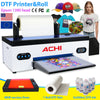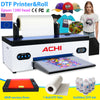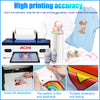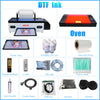How to Print DTF on Black T-shirts by ACHI A3 Roll DTF Printer?
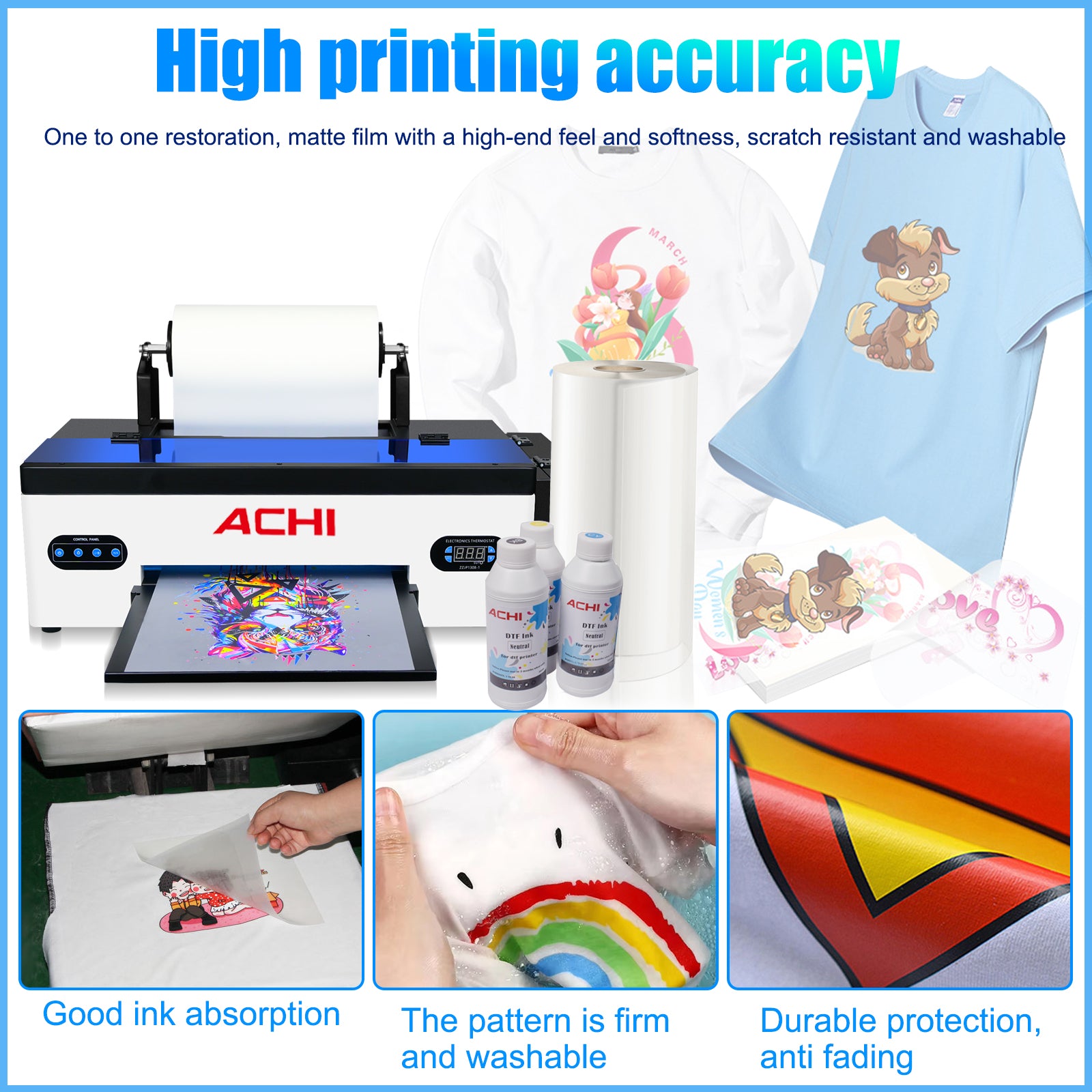
Printing vibrant, detailed designs onto black t-shirts has always presented a challenge.
While screen printing requires complex underbasing, Direct-to-Film (DTF) technology offers a simpler, more accessible solution, especially for custom jobs and small batches.
The ACHI A3 Roll DTF printer streamlines this process, leveraging roll-to-roll functionality for continuous printing.
Here's how to achieve professional results on black cotton tees using this printer:
Why DTF Excels on Blacks: The magic lies in the white ink underbase printed onto the transfer film.
This opaque layer blocks the dark garment color, allowing your colorful design elements to pop with maximum brightness and opacity – something difficult to achieve reliably with methods like sublimation or traditional inkjet transfers on dark fabrics.

Materials You'll Need:
- ACHI A3 Roll DTF Printer: Configured with CMYK + White ink.
- DTF PET Film (Roll): Specifically designed for DTF printing.
- DTF Hot Melt Powder: Fine mesh powder (usually ~120 mesh).
- Powder Shaker or Automatic Powdering Unit: For even powder application.
- Curing Oven/Dryer: To melt the powder adhesive (convection oven or dedicated DTF dryer).
- Heat Press: Capable of reaching the necessary temperature and pressure, ideally with a swing-away mechanism.
- Black Cotton T-shirts: Pre-washed and dried (no fabric softener) to remove finishes.
- DTF RIP Software: For color management, white underbase generation, and printer control.
- Design Software: Adobe Photoshop, Illustrator, CorelDRAW, etc.
- Lint Roller: For pre-pressing garment prep.
Step-by-Step Guide:
-
Design Preparation (Software):
- Create or prepare your artwork. Ensure colors are in CMYK mode.
- Crucial for Black Shirts: Generate a solid white underbase layer beneath all colored elements where opacity is needed. This white layer is what blocks the black shirt and allows colors to shine. Your DTF RIP software is essential for automating and optimizing this underbase creation.
- Flip/Mirror your design horizontally. It will be printed face-down onto the film and then transferred face-up onto the shirt.
- Save your file in a format compatible with your RIP software (e.g., TIFF, PDF).
-
Printing onto DTF Film (ACHI A3 Roll DTF Printer):
- Load the roll of PET DTF film onto the ACHI A3's roll holder, ensuring it feeds smoothly.
- Load the CMYK + White inks into their respective channels. Ensure ink levels are sufficient.
- In your RIP software, select the ACHI A3 printer, choose the correct DTF profile (optimized for the film and ink), and set up your print job. Verify the white underbase settings.
- Initiate printing. The ACHI A3 will print the design (including the vital white layer) directly onto the PET film roll. Allow the printed film to sit for a minute or two until the ink is touch-dry (not cured).
-
Powder Application:
- Carefully move the printed film section to your powdering station.
- Manual: Gently shake the DTF powder evenly over the entire wet ink surface using a fine-mesh shaker box. Ensure complete coverage, especially over the white areas.
- Automatic: If using a powdering machine, feed the film through according to the unit's instructions.
- Crucial: Shake off or use compressed air (very carefully!) to remove ALL excess powder. Only powder adhered to the wet ink should remain. Excess powder causes issues later.
-
Curing the Powder:
- Transfer the powdered film to your curing oven/dryer.
- Cure at the recommended temperature and time (typically around 110-120°C / 212-230°F for 2-3 minutes). Always refer to your specific powder manufacturer's guidelines.
- The powder should melt completely, forming a smooth, clear, glossy adhesive layer over your design. Ensure it's fully melted and cooled.
-
Preparing the T-Shirt & Heat Press:
- Lay the black t-shirt flat on the heat press platen. Smooth out any wrinkles.
- Lint Roll: Thoroughly go over the area where the transfer will be applied to remove any lint or debris.
- Pre-heat/press the garment for 1-2 seconds to remove moisture and wrinkles if needed.
- Set your heat press:
- Temperature: 150-160°C (300-320°F) - Confirm based on powder/film specs.
- Pressure: Medium to Firm (Follow heat press and powder manufacturer recommendations).
- Time: 10-15 seconds - Adjust based on testing, fabric, and specific materials.
-
Transferring the Design (Hot Peel):
- Place the cured film onto the shirt, adhesive (powder) side down onto the fabric. Design facing up.
- Cover with a Teflon sheet or baking paper to protect the heat press elements.
- Firmly close the heat press and apply heat/pressure for the set time (10-15 sec).
- Immediately after the timer goes off, open the press. Carefully peel the PET film back on itself WHILE IT'S STILL HOT (180°F / 82°C or hotter) in one smooth, decisive motion. This is the "Hot Peel" method, crucial for achieving soft, flexible prints on fabric. Do not let it cool first!
- Allow the transferred design on the shirt to cool completely.

ACHI A3 Roll DTF Printer Advantages for Black T-Shirts:
- Roll-to-Roll Efficiency: Ideal for batch production, minimizing manual film handling and feeding compared to sheet-fed printers.
- Integrated White Ink System: Essential for creating the opaque underbase needed for vibrant prints on dark fabrics.
- Optimized for DTF: Engineered to handle DTF inks and films effectively.
- Automation Potential: Streamlines the printing stage for higher productivity.
Tips for Success:
- Test First: Always run a test print and transfer on a scrap garment before printing your final products. Adjust time/temp/pressure as needed.
- Underbase is Key: Ensure the white underbase layer under your colors is solid and sufficient.
- Excess Powder is the Enemy: Meticulously remove all loose powder after application.
- Hot Peel: Peeling while the transfer is still very hot (Hot Peel) is critical for softness on fabric. Cold peeling often results in a stiffer feel.
- Fabric Matters: 100% cotton or high-cotton blends work best. Avoid fabrics with silicone coatings or high polyester/content unless using specialized powders/adhesives.
- Maintenance: Regularly maintain your ACHI A3 printer (printhead cleans, wiper checks) to prevent clogs, especially with white ink.
- Cure Thoroughly: Properly curing the powder ensures good adhesion.
- Press Firmly & Evenly: Ensure consistent pressure across the entire design area during transfer.
By above these steps and leveraging the capabilities of the ACHI A3 Roll DTF Printer, you can consistently produce vibrant, durable, and soft-feeling prints on black t-shirts. The roll-fed system enhances efficiency, making it a strong choice for businesses focusing on custom apparel and short runs.
-
Posted in
DTF printer
